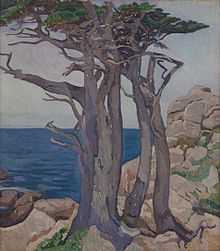Anne Bremer
Anne Bremer (May 21, 1868 – October 26, 1923) was a California painter,[1] influenced by Post-Impressionism, who was called "the most 'advanced' artist in San Francisco" in 1912 after art studies in New York and Paris.[2] She was described in 1916 as “one of the strong figures among the young moderns”[3] and later as “a crusader for the modern movement.” [4] She had numerous solo exhibitions, including one at Arlington Galleries in New York in 1917. After developing leukemia in about 1921, she gave up painting and wrote poetry.

Life
Anne Milly[5] Bremer was born in San Francisco on May 21, 1868, to upper-middle-class German-Jewish immigrants Joseph and Minna Bremer. In 1880-81 she traveled in Europe with her parents, and they brought back a cousin, Albert Bender, from Dublin, Ireland, to live with them and work for another uncle, William Bremer. She studied art with Emil Carlsen at the San Francisco Art Students League and with Arthur Mathews and others at the California School of Design, Mark Hopkins Institute of Art, receiving a Certificate of Proficiency in 1898.[6] By the time she graduated she was on the board of the Sketch Club, an organization of San Francisco women artists, and she was its president at the time of the 1906 San Francisco Earthquake.[7] Under her leadership the Sketch Club produced the first major art exhibition in the city after the disaster and enlarged its membership to include men. In 1916 she was elected secretary of the San Francisco Art Association, where she helped lead a major phase of growth in conjunction with the creation of an art museum at the Palace of Fine Arts.
Bremer’s work incorporates several elements associated with modern painting. Each of her paintings calls attention to itself as a flat surface holding an arrangement of colored paint, not as a literal representation or illusion of reality. Brushstrokes are broad and distinct from one another, sometimes with areas of unpainted canvas showing through. There is either very little suggestion of depth, or the perspective is distorted or ambiguous. Colors are bold and not always naturalistic. The subject might be figures, landscape, still life or a combination of these, but what was more important to the artist was creating a successful composition and emotional effect. Her works, while individualistic, are sometimes reminiscent of those of Robert Henri and Marsden Hartley, two of the major figures in modern American art. Hartley once wrote that in his opinion Anne Bremer was “one of the three artists of real distinction that California has produced.”[8]

Legacy
Following her death in 1923, Albert Bender established several memorials, including an award for art students and the Anne Bremer Memorial Library at the San Francisco Art Institute,[9] a marble chair in the Greek Theatre at the University of California, Berkeley, and an outdoor sculpture at Mills College. He also sponsored publication of a pair of limited edition books, The Unspoken and Other Poems and Tributes to Anne Bremer (Printed by John Henry Nash, 1927). Through Anne Bremer's influence and contacts with artists, Albert Bender was inspired to become an important patron of artists and art museums and a founder of the San Francisco Museum of Modern Art and Mills College Art Museum.[10]
Solo exhibitions
- 1912 Vickery, Atkins and Torrey, San Francisco
- 1912 St. Francis Hotel, San Francisco
- 1913 Friday Morning Club, Los Angeles
- 1914 Helgesen Galleries, San Francisco
- 1916 Hill Tolerton Gallery, San Francisco
- 1917 Arlington Galleries, New York
- 1922 Print Rooms, San Francisco
- 1923 Memorial exhibitions, Print Rooms and San Francisco Museum of Fine Arts
Museum collections
- Crocker Art Museum, Sacramento, CA
- Mills College Art Museum, Oakland, CA
- Oakland Museum of California
- San Diego Museum of Art
- San Francisco Museum of Modern Art
Notes
- ↑ "Anne M. Bremer (1868-1923)". George Stern Fine Arts.
- ↑ Porter Garnett, “News Notes of the Artist Folk,” San Francisco Call, 15 September 1912, p. 70.
- ↑ Laura Bride Powers, “News of Artists, Art and Studios,” Oakland Tribune, 26 November 1916, p. 34.
- ↑ Beatrice Judd Ryan, “The Rise of Modern Art in the Bay Area,” in California Historical Society Quarterly, v. 38 (1959), p. 2.
- ↑ Some sources spell her middle name "Millay," but an artist card in her own handwriting at the California State Library lists it as "Milly."
- ↑ "Anne Millay Bremer (1868-1923)". Trotter Galleries.
- ↑ Louis Stellman, “Local Artists Reestablishing Their Colony,” San Francisco Chronicle, 30 June 1907, p. 5.
- ↑ As quoted (or paraphrased) by Ruth Pielkovo, San Francisco Journal, April 2, 1922; original source unknown.
- ↑ "Anne Bremer Memorial Library". San Francisco Art Institute.
- ↑ "Our Mission". Mills College Art Museum.
Selected bibliography
- Ruth Lilly Westphal, ed. (1986). Plein Air Painters of California: The North. ISBN 0961052015
- Gene Hailey, ed. (1937). California Art Research (WPA Project 2874, O.P. 65-3-3632), vol. 7, pp. 87–128. Retrieved on 5 March 2012.
- Phyllis Ackerman, "A Woman Painter With a Man's Touch," Arts and Decoration. April 1923, p. 20.
- Ray Boynton, "Ruth Armer's Caricature Dolls . . . ," San Francisco Chronicle. 17 September 1922, p. D4.
- "Anne Bremer Returns to Exhibit Work." San Francisco Chronicle. 9 April 1922, p. F8.
- Helen Appleton Read, [exhibition review]. Brooklyn Daily Eagle. 4 November 1917.
- Blanche M. d'Harcourt, "In Anne Bremer's Studio." The Wasp (San Francisco). 23 June 1917.
- Alma May Cook, "Conservative Post Impressionist: Miss Bremer Has Applied American Good Sense to This Phase of French Art." Los Angeles Express. 25 January 1913.
- "Miss Anne M. Brewer [sic] Has Interesting Art Exhibit: Canvases Depict Scenes That Are Unique in Artists' World." San Francisco Chronicle. 24 March 1912, p. 30.